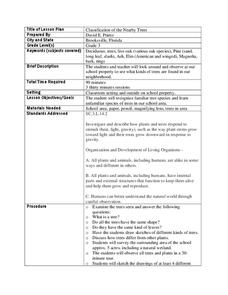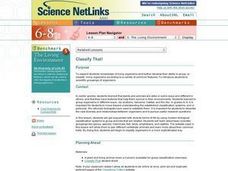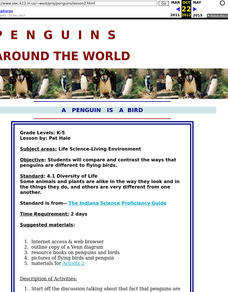Curated OER
The Discovery of OXygen
High schoolers conduct experiments to identify the different properties of oxygen. In this chemistry activity, students examine its importance to life on Earth. They explore the historic dispute about oxygen's discovery.
Curated OER
Classifying Vertebrates
Second graders study animal characteristics and classification. In this animal characteristics and classifications instructional activity, 2nd graders determine how to classify vertebrates which include mammals, reptiles, amphibians,...
Curated OER
Is It Slimy? Does It Have Fur? Is It Really a Bird?
Sixth graders identify the different types of vertebrate animals based upon their major characteristics, as they create collages in groups. Collages show pictures of vertebrate animals labeled with the appropriate structural...
Curated OER
Sibling Relationships in the Animal World
Students research sibling relationships in the animal world. In this animal science lesson plan, students read the book, Sisters and Brothers: Sibling Relationships in the Animal World and discuss the sibling relationships. Students...
Curated OER
You...Instead of the Onion Skin
Learners observe their own epithelial cells from the inside linings of their cheeks using DigiScope technology. They prepare a slide with both onion cells and epithelial cells and make an illustrated booklet for a PowerPoint presentation...
Curated OER
We're All In This Together
Students discover what a coral reef is and the animals that live there. In this ecosystem lesson, students act out a story with ocean organisms. They answer questions that show the interdependency of the sea animals.
Curated OER
Classification of the Nearby Trees
Third graders practice using classification techniques to identify local trees. In this plant life instructional activity, 3rd graders discuss how trees differ from other plants and what characteristics are unique to trees alone....
Curated OER
Trait Variations for Survival
Young learners examine how different traits could give one organism an advantage over another. In groups, they view two different organisms in different environments. To end the lesson, they complete a Venn Diagram on the two organisms...
Curated OER
Fun Activities Using Seeds
Students analyze the size, shape, and form of several different seeds. In this all about seeds lesson plan, students complete four activities involving characteristics of seeds. Students observe the seeds, record information about the...
Curated OER
What Do You Know About the Birds Around You?
Students compare and contrast various species of birds. After participating in a brief discussion of the characteristics of birds, they view birds in their natural habitat and in pictures with a focus on the similarities and differences...
Curated OER
Dinosaurs 2: What Were Dinosaurs Like?
Learners compare and contrast dinosaurs to animals that are alive today through basic research.
Curated OER
Which Herp Is Which?
Students research different kinds of herps. The teacher gives the student a particular herp and the student writes a postcard (as the herp) to an in-class penpal, giving hints about the herp, but not identifying itself.
Curated OER
Classify That!
Students explore diverse forms of life by using modern biological classification systems to group animals that are related. Students then study basic scientific groupings like genus, species, mammals, fish, birds, amphibians, and...
Curated OER
Classify That!
Students get acquainted with diverse forms of life by using modern biological classification systems to group animals that are related. They explore basic scientific groupings like genus, species, mammals, fish, birds, amphibians, and...
Curated OER
SKULL DIVERSITY
Middle schoolers explore the similarities and differences of animal skulls.
Curated OER
Treetures
Students identify the different forests of the world and some of the characteristics that differentiate them. They explore old magazines, calendars and photos and fill out a scavenger hunt worksheet.
Curated OER
A Penguin is a Bird
Pupils compare and contrast the ways that penguins are different to flying birds.
Curated OER
A Virtual Museum of the Mojave Desert
Students study deserts and the plants, animals, and people who inhabit them. In groups, they create their own stories about the inhabitants of the Mojave desert.
Curated OER
IDENTIFYING AND SORTING BEARS
Students study the difference between living and nonliving bears by classifying pictures of bears and placing them on the appropriate posterboard. Given pictures of bears, students recognize types of bears by placing the pictures correctly.
Curated OER
The Plant and Animal Walk
Students draw pictures and write words to describe objects and experiences. They observe outside and draw at least three animals and three plants. Students observe plants and animals describing how they are alike and how they are...
Curated OER
Breed Twins-Dog Breeds
In this online quiz worksheet, students answer a set of trivia questions about dog breeds. The page has a link to submit answers for review.
Curated OER
Dromedary and Bactrian Venn Diagram
In this camel Venn Diagram worksheet, students compare dromedary and Bactrian camels by completing the Venn Diagram for the animals.
Georgia Department of Education
Living Things/ Nonliving Things
How can you tell if something is living or nonliving? Introduce a set of criteria which can be used to determine which things are alive and which are not. The class discusses the basic needs of all living organisms, checks out an...
Curated OER
Plant Parts
Little ones identify the parts of a plant and practice following directions at the same time. They color each part of the flowering plant the color indicated on the sheet. Roots are brown, leaves are green, the flower is red, and the...

























